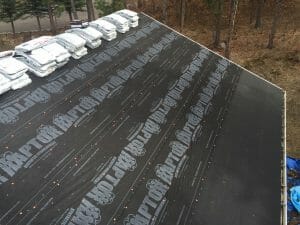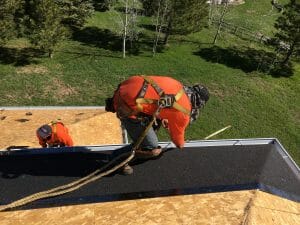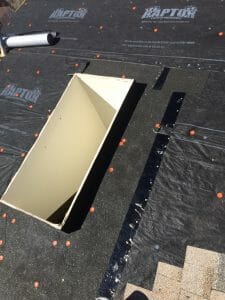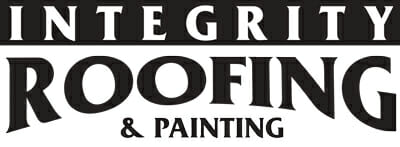Tell me about ice and water shield

Ice And Water Shield And Synthetic Underlayment
Ice and water shield is a water proof underlayment that may be a part of your roof system. This is rather profound for until recently this product didn’t exist. Technological advances in the roofing industry provide greater peace of mind for many homeowners, especially in areas of the country that experience heavy snow loads and ice dams.
Denver, Colorado and ice dams
The nefarious ice dam is a repeat offender in Denver, Colorado. How can the roof be protected from ice dams?
Traditional underlayment is water resistant and certainly not water proof. Here in Colorado we get our fair share of snow and ice dams. That’s the bad news. Now, for the good news; ice and water shield was created to prevent any damage that may result from an ice dam. In Colorado, you’ll find that Denver roofers should be installing ice and water shield in areas where there is a history of ice dams. Please consult with your roofing contractor to discuss installation of ice and water shield.
How does Ice and Water Shield work?
This water proofing underlayment is made of asphalt that is modified with plastic that prevents moisture from penetrating this protective barrier. Currently, this product comes on a roll that is approximately 3’ wide.
Most underlayments are fastened, however ice and water shield is uniquely designed and it is the only underlayment that is not fastened. In fact this product has a factory applied adhesive. On the back side of this underlayment is a product similar to butcher paper that is part of the factory packaging. When ice and water shield is installed the roofer removes this wax like paper so the adhesive sealant adheres to the wood deck. Ice and water shield has to be installed directly to a clean and solid wood surface.
Another aspect of ice and water shield is the unique ability of this product to heal itself. Well that may be a little bit of a stretch in defining it, but this product will swell around the nails that penetrate it. This is necessary, for an underlayment to be water resistant when the overlaying shingles are installed, than it must seal around the nails.
Installing Ice and Water Shield on the roof’s eave

Ice And Water Shield On The Eave
The eave is where a gutter trough is traditionally located. If you have no guttering on your home than it is the horizontal plane on the roofs edge where the fascia trim is installed and this is where water is shed from the roof. Here’s the number one reason why roofer’s install the ice and water shield on the roof’s eave and it’s because local building codes may require this product. The second reason is because a shingle manufacturer may require this product to be installed in certain geographic locations.
Ice dams typically form along the roofs eave in areas where snow loads are prevalent on roofs. If a home is properly ventilated the impact of ice dams are minimized. Heating wires can be installed to help reduce the impact of ice dams on the roofs edge. Your homes last line of defense against ice dams could be ice and water shield.
Even if local building codes in Denver, Colorado don’t require ice and water shield, and you want to build your new roof system to withstand ice dams, ask one of the Denver roofers to add ice and water shield along the roof’s eave.
Water follows both gravity and the least path of resistance, most of the time. However, there are times when water is blocked and begins to travel uphill. This is exactly what occurs during an ice dam along the roofs eave. Many times the ice begins forming in the gutter and begins to climb uphill.
During a typical day the roof warms up during the day and begins to melt the snow on the roof. At night time water along the roofs edge and in the gutter freezes and begins to form an ice dam along the roofs edge. If the weather climate in your region is idea for forming ice dams, than it would be most beneficial for that roof to have ice and water shield to prevent interior damage during the freeze and thaw cycles.
If the roof is protected to a sufficient height along the roofs eave than the ice and water shield will prevent moisture from causing any interior damage. If too little ice and water shield is installed than damage may eventually occur. Sometimes, it may be advisable to install more ice and water shield than what code requires.
The roofing contractor certainly would not be responsible for installing ice and water shield per code and if at the same time damage resulted from an ice dam. What occurred is that the ice dams exceeding the quantity of water proof underlayment that was installed. If you’re concerned that this might occur on your home than ask your contractor to install more ice and water shield along your roofs edge. This may very well be a good idea if you’re home has a lot of ice dams.
Installing ice and water along wall abutments
New home builders should incorporate the installation of ice water shield along the roof slope and up the wall where a wall and sloping roof intersect. This should be done prior to the installation of roof flashing and obviously before the exterior walls are sided, bricked or finished with stucco or stone work. Wall and sloping roof intersections are vulnerable areas and of particular concern where an ice dam may form. Ice dams may create capillary action where water begins to climb uphill and work it’s way underneath shingles and underlayment. If a self adhering, self healing water proof ice and water shield is installed on both the sloping roof and up the wall than it would minimize or stop any water from entering into the structure.
Ice and water shield can be installed when a home is re-shingled, however it will be installed only on the sloping roofs surface and not up the wall. If a homeowner wants the ice and water shield to be installed up the wall than it would be something that is over and above the regular scope. While installing the ice and water shield on the roofs slope the old wall flashing should be lifted up and the ice and water shield must be installed directly to the wood deck. The old flashing or new flashing is to be installed on top of the ice and water shield. Ice and water shield isn’t designed to be installed on top of metal. It must be installed only on a clean wood surface. However, there is one exception to the rule and I’ll tell you about that in a moment.
Ice and Water Shield in the valley
Traditionally 90# roll roofing, double felt, or metal was installed on most valley installations. Today ice and water shield is replacing the “old school” methods. Don’t get me wrong we still install metal in the valley on certain projects, yet we install ice and water shield underneath of the metal. On all other installs ice and water shield is currently being installed on all of our roof valleys. Here’s the reasoning the valley is an extremely vulnerable area and we’ve found that ice and water shield provides there greatest amount of protection because it adheres directly to the wood deck water can’t penetrate the valley.
Ice and Water Shield around skylight’s and chimney’s

Ice And Water Shield Around Skylight
Let’s not forget about skylights and chimneys. Water flow is blocked by both skylight and chimney, therefore a water proofing underlayment may be an integral component for diverting water. At Integrity Roofing and Painting, LLC we have incorporated ice and water shield as a standard component when we are flashing around chimneys and skylights.
As an astute observer and professional roofer Denver has it’s issues with roof leaks; due to lack of quality control and allowing roofs to be built with less than desirable standards, roofs are not what they could be. I’d love to see changes in the roofing practices of Denver Roofers and for codes to become more stringent. Integrity Roofing and Painting, LLC is one of the premier roofing contractors in Denver, CO and exercises strict compliance to building codes and beyond. Contact Integrity Roofing and Painting, LLC to install your new roof with the addition of ice and water shield in critical areas to withstand the elements. We make roof replacements easy!

